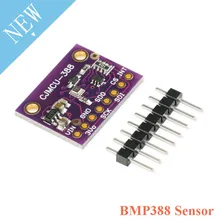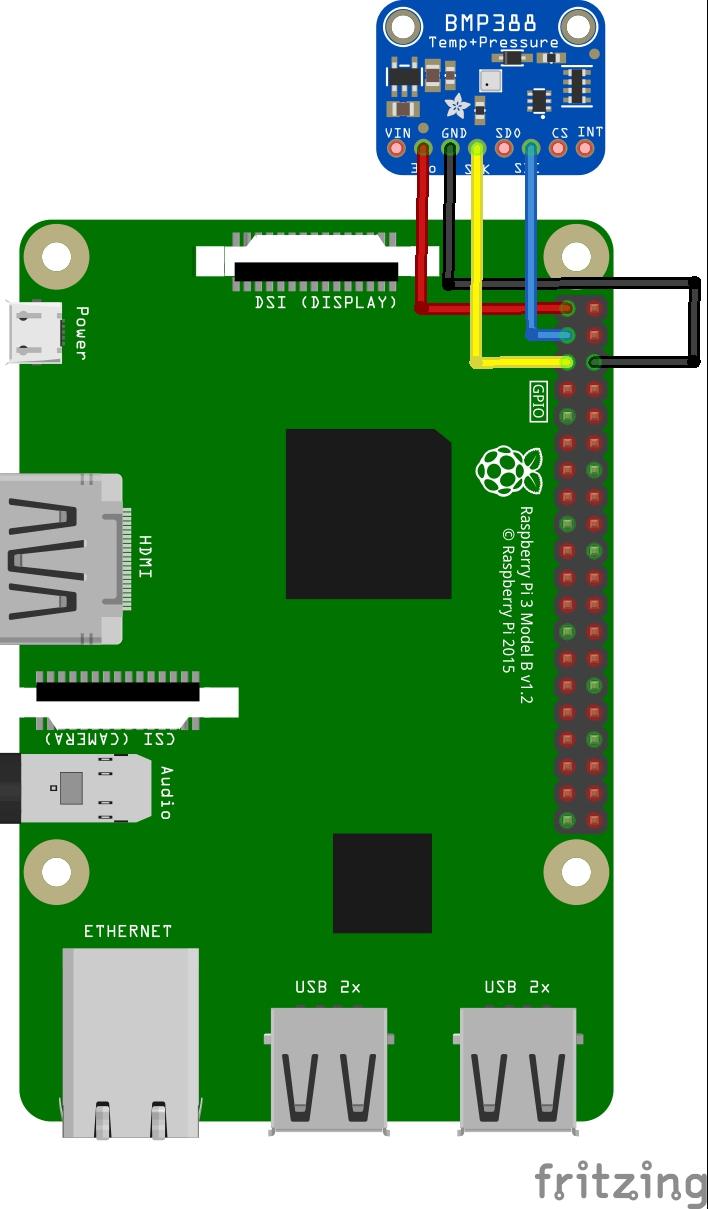In this article we look at another sensor – it is a BMP388 by Bosch Sensortec, so lets crack on and try this out with a Raspberry Pi 3
BMP388 Information
The BMP388 is a very small, low-power and low-noise 24 bit absolute barometric pressure sensor. It enables accurate altitude tracking and is specifically suited for drone applications. The best-in-class TCO of the BMP388 between 0-65°C for accurate altitude measurement over a wide temperature range greatly enhances the drone flying experience by making accurate steering easier.
It is compatible for use with other Bosch sensors, including BMI088 for better performance, robustness and stability.
The BMP388 sensor offers outstanding design flexibility, providing a single package solution that is easy to integrate into other existing and upcoming devices such as smart homes, industrial products and wearables.
It is more accurate than its predecessors, covering a wide measurement range from 300 hPa to 1250 hPa. BMP388 exhibits an attractive price-performance ratio coupled with low power consumption. It is available in a compact 10-pin 2.0 x 2.0 x 0.75 mm³ LGA package with metal lid.
- Operating voltage: 3.3V/5V
- Communication interface: I2C/SPI
- Barometric pressure operation range: 300~1250hPa
- Barometric pressure absolute accuracy: ±0.40hPa (@900~1100hPa, 25~40℃)
- Barometric pressure relative accuracy: ±0.08hPa (@900~1100hPa, 25~40℃)
- Temperature coefficient offset: ±0.75Pa/K (@700~1100hPa, -20~65℃))
- Temperature absolute accuracy: ±0.5℃ (0~65℃)
- Possible resolution: 0.016Pa (high precision mode)
- Possible sampling rate: 200Hz
- Operating voltage: -40~85℃
If you purchase a module they will have a 3.3v regulator on board, you will also have the option of I2C or SPI, here is the module that I located.
Parts Required
| Name | Link |
| Raspberry Pi 4 | Aliexpress product link |
| BMP388 pressure sensor |
Aliexpress product linkAmazon link |
| Connecting wire | Aliexpress product link |
Schematic/Connection
I decided to use the sensor in I2C mode – I also decided to use 3.3v from the Raspberry PI 3 but could have quite easily used 5v from the board
Code Example
Copy the following code as bmp388.py. I use Mu in the latest Raspbian release and paste this code and run it
[codesyntax lang=”cpp”]
#!/usr/bin/python
# -*- coding: utf-8 -*-
import time
import smbus
import math
# define BMP388 Device I2C address
I2C_ADD_BMP388_AD0_LOW = 0x76
I2C_ADD_BMP388_AD0_HIGH = 0x77
I2C_ADD_BMP388 = I2C_ADD_BMP388_AD0_HIGH
BMP388_REG_ADD_WIA = 0x00
BMP388_REG_VAL_WIA = 0x50
BMP388_REG_ADD_ERR = 0x02
BMP388_REG_VAL_FATAL_ERR = 0x01
BMP388_REG_VAL_CMD_ERR = 0x02
BMP388_REG_VAL_CONF_ERR = 0x04
BMP388_REG_ADD_STATUS = 0x03
BMP388_REG_VAL_CMD_RDY = 0x10
BMP388_REG_VAL_DRDY_PRESS = 0x20
BMP388_REG_VAL_DRDY_TEMP = 0x40
BMP388_REG_ADD_CMD = 0x7E
BMP388_REG_VAL_EXTMODE_EN = 0x34
BMP388_REG_VAL_FIFI_FLUSH = 0xB0
BMP388_REG_VAL_SOFT_RESET = 0xB6
BMP388_REG_ADD_PWR_CTRL = 0x1B
BMP388_REG_VAL_PRESS_EN = 0x01
BMP388_REG_VAL_TEMP_EN = 0x02
BMP388_REG_VAL_NORMAL_MODE = 0x30
BMP388_REG_ADD_PRESS_XLSB = 0x04
BMP388_REG_ADD_PRESS_LSB = 0x05
BMP388_REG_ADD_PRESS_MSB = 0x06
BMP388_REG_ADD_TEMP_XLSB = 0x07
BMP388_REG_ADD_TEMP_LSB = 0x08
BMP388_REG_ADD_TEMP_MSB = 0x09
BMP388_REG_ADD_T1_LSB = 0x31
BMP388_REG_ADD_T1_MSB = 0x32
BMP388_REG_ADD_T2_LSB = 0x33
BMP388_REG_ADD_T2_MSB = 0x34
BMP388_REG_ADD_T3 = 0x35
BMP388_REG_ADD_P1_LSB = 0x36
BMP388_REG_ADD_P1_MSB = 0x37
BMP388_REG_ADD_P2_LSB = 0x38
BMP388_REG_ADD_P2_MSB = 0x39
BMP388_REG_ADD_P3 = 0x3A
BMP388_REG_ADD_P4 = 0x3B
BMP388_REG_ADD_P5_LSB = 0x3C
BMP388_REG_ADD_P5_MSB = 0x3D
BMP388_REG_ADD_P6_LSB = 0x3E
BMP388_REG_ADD_P6_MSB = 0x3F
BMP388_REG_ADD_P7 = 0x40
BMP388_REG_ADD_P8 = 0x41
BMP388_REG_ADD_P9_LSB = 0x42
BMP388_REG_ADD_P9_MSB = 0x43
BMP388_REG_ADD_P10 = 0x44
BMP388_REG_ADD_P11 = 0x45
class BMP388(object):
“””docstring for BMP388″””
def __init__(self, address=I2C_ADD_BMP388):
self._address = address
self._bus = smbus.SMBus(0x01)
# Load calibration values.
if self._read_byte(BMP388_REG_ADD_WIA) == BMP388_REG_VAL_WIA:
print(“Pressure sersor is BMP388!\r\n”)
u8RegData = self._read_byte(BMP388_REG_ADD_STATUS)
if u8RegData & BMP388_REG_VAL_CMD_RDY:
self._write_byte(BMP388_REG_ADD_CMD,
BMP388_REG_VAL_SOFT_RESET)
time.sleep(0.01)
else:
print (“Pressure sersor NULL!\r\n”)
self._write_byte(BMP388_REG_ADD_PWR_CTRL,
BMP388_REG_VAL_PRESS_EN
| BMP388_REG_VAL_TEMP_EN
| BMP388_REG_VAL_NORMAL_MODE)
self._load_calibration()
def _read_byte(self, cmd):
return self._bus.read_byte_data(self._address, cmd)
def _read_s8(self, cmd):
result = self._read_byte(cmd)
if result > 128:
result -= 256
return result
def _read_u16(self, cmd):
LSB = self._bus.read_byte_data(self._address, cmd)
MSB = self._bus.read_byte_data(self._address, cmd + 0x01)
return (MSB << 0x08) + LSB
def _read_s16(self, cmd):
result = self._read_u16(cmd)
if result > 32767:
result -= 65536
return result
def _write_byte(self, cmd, val):
self._bus.write_byte_data(self._address, cmd, val)
def _load_calibration(self):
print (“_load_calibration\r\n”)
self.T1 = self._read_u16(BMP388_REG_ADD_T1_LSB)
self.T2 = self._read_u16(BMP388_REG_ADD_T2_LSB)
self.T3 = self._read_s8(BMP388_REG_ADD_T3)
self.P1 = self._read_s16(BMP388_REG_ADD_P1_LSB)
self.P2 = self._read_s16(BMP388_REG_ADD_P2_LSB)
self.P3 = self._read_s8(BMP388_REG_ADD_P3)
self.P4 = self._read_s8(BMP388_REG_ADD_P4)
self.P5 = self._read_u16(BMP388_REG_ADD_P5_LSB)
self.P6 = self._read_u16(BMP388_REG_ADD_P6_LSB)
self.P7 = self._read_s8(BMP388_REG_ADD_P7)
self.P8 = self._read_s8(BMP388_REG_ADD_P8)
self.P9 = self._read_s16(BMP388_REG_ADD_P9_LSB)
self.P10 = self._read_s8(BMP388_REG_ADD_P10)
self.P11 = self._read_s8(BMP388_REG_ADD_P11)
# print(self.T1)
# print(self.T2)
# print(self.T3)
# print(self.P1)
# print(self.P2)
# print(self.P3)
# print(self.P4)
# print(self.P5)
# print(self.P6)
# print(self.P7)
# print(self.P8)
# print(self.P9)
# print(self.P10)
# print(self.P11)
def compensate_temperature(self, adc_T):
partial_data1 = adc_T – 256 * self.T1
partial_data2 = self.T2 * partial_data1
partial_data3 = partial_data1 * partial_data1
partial_data4 = partial_data3 * self.T3
partial_data5 = partial_data2 * 262144 + partial_data4
partial_data6 = partial_data5 / 4294967296
self.T_fine = partial_data6
comp_temp = partial_data6 * 25 / 16384
return comp_temp
def compensate_pressure(self, adc_P):
partial_data1 = self.T_fine * self.T_fine
partial_data2 = partial_data1 / 0x40
partial_data3 = partial_data2 * self.T_fine / 256
partial_data4 = self.P8 * partial_data3 / 0x20
partial_data5 = self.P7 * partial_data1 * 0x10
partial_data6 = self.P6 * self.T_fine * 4194304
offset = self.P5 * 140737488355328 + partial_data4 \
+ partial_data5 + partial_data6
partial_data2 = self.P4 * partial_data3 / 0x20
partial_data4 = self.P3 * partial_data1 * 0x04
partial_data5 = (self.P2 – 16384) * self.T_fine * 2097152
sensitivity = (self.P1 – 16384) * 70368744177664 \
+ partial_data2 + partial_data4 + partial_data5
partial_data1 = sensitivity / 16777216 * adc_P
partial_data2 = self.P10 * self.T_fine
partial_data3 = partial_data2 + 65536 * self.P9
partial_data4 = partial_data3 * adc_P / 8192
partial_data5 = partial_data4 * adc_P / 512
partial_data6 = adc_P * adc_P
partial_data2 = self.P11 * partial_data6 / 65536
partial_data3 = partial_data2 * adc_P / 128
partial_data4 = offset / 0x04 + partial_data1 + partial_data5 \
+ partial_data3
comp_press = partial_data4 * 25 / 1099511627776
return comp_press
def get_temperature_and_pressure_and_altitude(self):
“””Returns pressure in Pa as double. Output value of “6386.2”equals 96386.2 Pa = 963.862 hPa.”””
xlsb = self._read_byte(BMP388_REG_ADD_TEMP_XLSB)
lsb = self._read_byte(BMP388_REG_ADD_TEMP_LSB)
msb = self._read_byte(BMP388_REG_ADD_TEMP_MSB)
adc_T = (msb << 0x10) + (lsb << 0x08) + xlsb
temperature = self.compensate_temperature(adc_T)
xlsb = self._read_byte(BMP388_REG_ADD_PRESS_XLSB)
lsb = self._read_byte(BMP388_REG_ADD_PRESS_LSB)
msb = self._read_byte(BMP388_REG_ADD_PRESS_MSB)
adc_P = (msb << 0x10) + (lsb << 0x08) + xlsb
pressure = self.compensate_pressure(adc_P)
altitude = 4433000 * (0x01 – pow(pressure / 100.0 / 101325.0,
0.1903))
return (temperature, pressure, altitude)
if __name__ == ‘__main__’:
import time
print(“BMP388 Test Program …\n”)
bmp388 = BMP388()
while True:
time.sleep(0.5)
temperature,pressure,altitude = bmp388.get_temperature_and_pressure_and_altitude()
print(‘ Temperature = %.1f Pressure = %.2f Altitude =%.2f ‘%(temperature/100.0,pressure/100.0,altitude/100.0))
[/codesyntax]
Output
You should see the following – this is what I saw in Mu
BMP388 Test Program …
Pressure sersor is BMP388!
_load_calibration
Temperature = 24.0 Pressure = 99254.79 Altitude =173.80
Temperature = 24.0 Pressure = 99236.03 Altitude =175.39
Temperature = 24.0 Pressure = 99252.65 Altitude =173.98
Temperature = 24.1 Pressure = 99242.20 Altitude =174.87
Temperature = 24.0 Pressure = 99240.18 Altitude =175.04
Temperature = 24.1 Pressure = 99261.97 Altitude =173.19
Temperature = 24.1 Pressure = 99237.04 Altitude =175.31
Links
The code example is best downloaded from our github link, the original one had a few python indentation quirks which we ironed out to get this running.
https://github.com/getelectronics/PIBits/blob/master/python/bmp388.py
Summary
A nice little sensor but at just over $8 but one again there are cheaper sensors available which have the same functionality and for most projects have acceptable performance.




